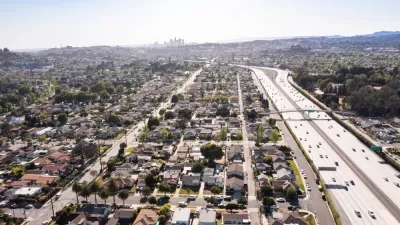A new report details the reach of California’s controversial environmental regulation, and warns of more consequences to come.

The Center for Jobs & the Economy recently published a report [pdf] quantifying the effect of the California Environmental Quality Act (CEQA) on development proposals around the state.
The report—authored by Jennifer Hernandez, a land use and environment law attorney at the Holland & Knight law firm—finds that CEQA lawsuits challenged almost half of all development projects in the state in 2020.
“In 2020 alone, there were 47,999 housing units targeted in CEQA lawsuits,” according to the center’s website. In addition to housing, the report finds a “explosion” of CEQA lawsuits challenging renewable energy development projects in 2020.
Among the key points of the report is concern that the 2022 Scoping Plan underway at the California Air Resources Board, required by the state’s landmark climate change law, AB 32, is only likely to encourage more anti-development lawsuits under CEQA.
“The CARB 2022 Scoping Plan, by implication and omission, invites more CEQA lawsuits against any type of housing that falls outside a limited number of housing types, all of which are infeasible, expensive, and frequently the target of CEQA lawsuits,” according to the website. “The CARB 2022 Scoping Plan ‘Natural and Working Lands’ chapter calls for the immediate cessation of new housing and other development on lands not previously developed–not even the buildout of existing cities and projects.”
FULL STORY: Anti-Housing CEQA Lawsuits Filed in 2020 Challenge Nearly 50% of California’s Annual Housing Production

Planetizen Federal Action Tracker
A weekly monitor of how Trump’s orders and actions are impacting planners and planning in America.

Maui's Vacation Rental Debate Turns Ugly
Verbal attacks, misinformation campaigns and fistfights plague a high-stakes debate to convert thousands of vacation rentals into long-term housing.

Restaurant Patios Were a Pandemic Win — Why Were They so Hard to Keep?
Social distancing requirements and changes in travel patterns prompted cities to pilot new uses for street and sidewalk space. Then it got complicated.

In California Battle of Housing vs. Environment, Housing Just Won
A new state law significantly limits the power of CEQA, an environmental review law that served as a powerful tool for blocking new development.

Boulder Eliminates Parking Minimums Citywide
Officials estimate the cost of building a single underground parking space at up to $100,000.

Orange County, Florida Adopts Largest US “Sprawl Repair” Code
The ‘Orange Code’ seeks to rectify decades of sprawl-inducing, car-oriented development.
Urban Design for Planners 1: Software Tools
This six-course series explores essential urban design concepts using open source software and equips planners with the tools they need to participate fully in the urban design process.
Planning for Universal Design
Learn the tools for implementing Universal Design in planning regulations.
Heyer Gruel & Associates PA
JM Goldson LLC
Custer County Colorado
City of Camden Redevelopment Agency
City of Astoria
Transportation Research & Education Center (TREC) at Portland State University
Jefferson Parish Government
Camden Redevelopment Agency
City of Claremont




























